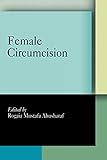Female Circumcision : Multicultural Perspectives / ed. by Rogaia Mustafa Abusharaf.
Material type: TextSeries: Pennsylvania Studies in Human RightsPublisher: Philadelphia : University of Pennsylvania Press, [2013]Copyright date: ©2006Description: 1 online resource (296 p.) : 2 illusContent type:
TextSeries: Pennsylvania Studies in Human RightsPublisher: Philadelphia : University of Pennsylvania Press, [2013]Copyright date: ©2006Description: 1 online resource (296 p.) : 2 illusContent type: - 9780812219418
- 9780812201024
- 391.2096 23
- GN645 .F43 2006eb
- online - DeGruyter
- Issued also in print.
| Item type | Current library | Call number | URL | Status | Notes | Barcode | |
|---|---|---|---|---|---|---|---|
 eBook
eBook
|
Biblioteca "Angelicum" Pont. Univ. S.Tommaso d'Aquino Nuvola online | online - DeGruyter (Browse shelf(Opens below)) | Online access | Not for loan (Accesso limitato) | Accesso per gli utenti autorizzati / Access for authorized users | (dgr)9780812201024 |
Frontmatter -- Contents -- Chapter 1. Introduction: The Custom in Question -- PART I. Local Contexts and Current Debates -- Chapter 2. "Had This Been Your Face, Would You Leave It as Is?" Female Circumcision Among the Nubians of Egypt -- Chapter 3. Male and Female Circumcision: The Myth of the Difference -- PART II. African Campaigns to Eradicate Female Circumcision -- Chapter 4. Community-Based Efforts to End Female Genital Mutilation in Kenya: Raising Awareness and Organizing Alternative Rites of Passage -- Chapter 5. A Community of Women Empowered: The Story of Deir El Barsha -- Chapter 6. Strategies for Encouraging the Abandonment of Female Genital Cutting: Experiences from Senegal, Burkina Paso, and Mali -- Chapter 7. The Sudanese National Committee on the Eradication of Harmful Traditional Practices and the Campaign Against Female Genital Mutilation -- Chapter 8. The Babiker Badri Scientific Association for Women's Studies and the Eradication of Female Circumcision in the Sudan -- Chapter 9. "My Grandmother Called It the Three Feminine Sorrows": The Struggle of Women Against Female Circumcision in Somalia -- PART III. Debates in Immigrant-Receiving Societies -- Chapter 10. The Double-Edged Sword: Using the Criminal Law Against Female Genital Mutilation in Canada -- Chapter 11 Representing Africa in the Kasinga Asylum Case -- Afterword: Safe Harbor and Homage -- Notes -- References -- Contributors -- Index -- Acknowledgments
restricted access online access with authorization star
http://purl.org/coar/access_right/c_16ec
Bolokoli, khifad, tahara, tahoor, qudiin, irua, bondo, kuruna, negekorsigin, and kene-kene are a few of the terms used in local African languages to denote a set of cultural practices collectively known as female circumcision. Practiced in many countries across Africa and Asia, this ritual is hotly debated. Supporters regard it as a central coming-of-age ritual that ensures chastity and promotes fertility. Human rights groups denounce the procedure as barbaric. It is estimated that between 100 million and 130 million girls and women today have undergone forms of this genital surgery.Female Circumcision gathers together African activists to examine the issue within its various cultural and historical contexts, the debates on circumcision regarding African refugee and immigrant populations in the United States, and the human rights efforts to eradicate the practice. This work brings African women's voices into the discussion, foregrounds indigenous processes of social and cultural change, and demonstrates the manifold linkages between respect for women's bodily integrity, the empowerment of women, and democratic modes of economic development.This volume does not focus narrowly on female circumcision as a set of ritualized surgeries sanctioned by society. Instead, the contributors explore a chain of connecting issues and processes through which the practice is being transformed in local and transnational contexts. The authors document shifts in local views to highlight processes of change and chronicle the efforts of diverse communities as agents in the process of cultural and social transformation.
Issued also in print.
Mode of access: Internet via World Wide Web.
In English.
Description based on online resource; title from PDF title page (publisher's Web site, viewed 24. Apr 2022)


